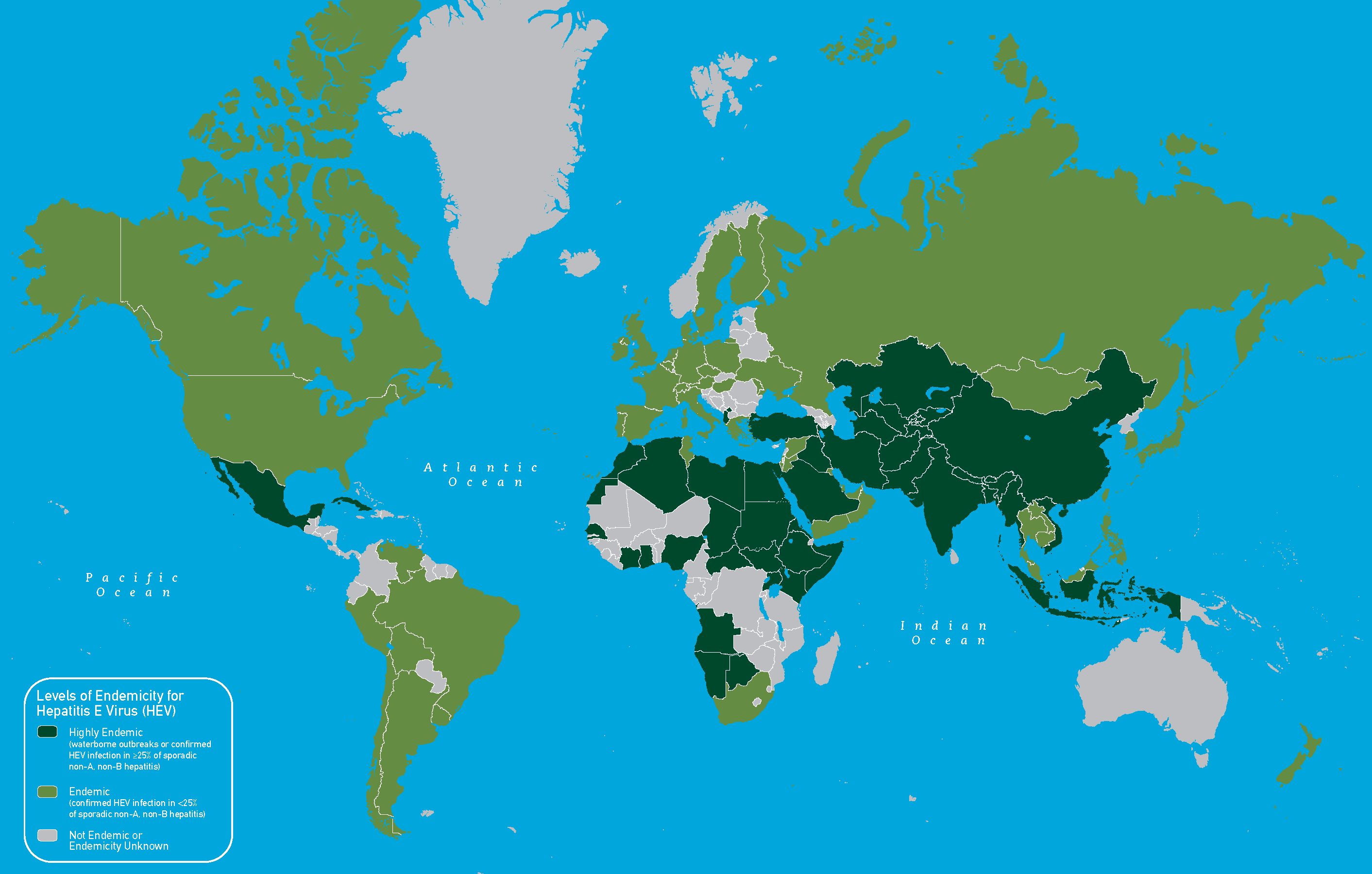Hepatitis E epidemiology and demographics
|
Hepatitis E Microchapters |
|
Diagnosis |
|---|
|
Treatment |
|
Hepatitis E epidemiology and demographics On the Web |
|
American Roentgen Ray Society Images of Hepatitis E epidemiology and demographics |
|
Risk calculators and risk factors for Hepatitis E epidemiology and demographics |
Editor-In-Chief: C. Michael Gibson, M.S., M.D. [1]; Associate Editor(s)-in-Chief: João André Alves Silva, M.D. [2]
Overview
An estimated 20 million HEV infections and 3.3 million acute cases occur annually worldwide with an estimated 56 600 deaths.[1] HEV displays different epidemiological and clinical characteristics between developing and developed countries.[2] In the United States, studies show an incidence of 700 cases per 100,000 of the overall population, and a seroprevalence of 21,000 per 100,000 persons. Clinical manifestations of hepatitis E are more frequent among adult patients. When compared to men, women have a smaller rate of hepatitis E (20,4% vs 21,6%). Pregnant women are more prone to develop severe cases of the disease. In developed countries, the disease often occurs as small outbreaks, commonly transmitted by ingestion of undercooked meat. In developing countries, the disease may occur as an epidemic, or as outbreaks, and is often associated with genotypes 1 and 2, which are transmitted through the ingestion of contaminated water.
Prevalence

In the United States, the seroprevalence of hepatitis E is 21,000 per 100,000 (21%) of the overall population.[3]
Incidence
The estimated annual incidence of hepatitis E in the United States is 700 per 100,000 (0.7%) of the overall population.[4]
Age
Clinical manifestations of hepatitis E are highest in young adults aged 15 to 49 years.[2] The rate of anti-HEV antibodies increases with age. According to a survey conducted in the US from 1988 to 1994, this rate can range from 10% (6 to 10 years) to 40% (>60 years).[5]
Gender
Women have a smaller rate of anti-HEV antibodies (20.4%) than men (21.6%).[3]
Pregnant Women
Although pregnant women have the same exposure to the virus as other people, due to their micronutrient status and cytokine levels, they are more prone to the severe form of the disease. [6]
In outbreak-prone areas, pregnant women (whether infected sporadically or during an epidemic) are at risk of progressing to liver failure and death after infection. Miscarriages and neonatal death occur commonly as a result of HEV infection.[2]
Race
After adjusting to age, the rate of anti-HEV antibodies was noted to be higher in non-hispanic whites (22.1%) than among blacks (14.5%).[5]
Developed Countries
Small outbreaks and individual cases of hepatitis E are often related to consumption of undercook pork, shellfish, as well as to blood transfusions.[6][7][8][9] The rate of anti-HEV antibodies is lower than in developing countries. [6]
Developing Countries
Hepatitis E may occur either as a sporadic case, or as an epidemic disease. It is often caused by genotypes 1 (Asia) and 2 (Central America and Africa).[10] Anti-HEV antibodies were detected in 30 to 80% of adults.[6]
The highest seroprevalence rates are observed in regions with low standards of sanitation, which increase the risk of viral transmission. Over 60% of all HEV infections and 65% of all hepatitis E deaths occur in East and South Asia, where seroprevalence rates of 25% are common in some age groups. In Egypt, half the population older than five years is serologically positive for the hepatitis E virus.[1]
Men in developing countries manifest symptoms of hepatitis E 2 to 5 times more than women during outbreaks.[11][12]
References
- ↑ 1.0 1.1 "Hepatitis E".
- ↑ 2.0 2.1 2.2 2.3 "Hepatitis E Epidemiology".
- ↑ 3.0 3.1 Kamar N, Bendall R, Legrand-Abravanel F, Xia NS, Ijaz S, Izopet J; et al. (2012). "Hepatitis E." Lancet. 379 (9835): 2477–88. doi:10.1016/S0140-6736(11)61849-7. PMID 22549046.
- ↑ Kantala T, Maunula L, von Bonsdorff CH, Peltomaa J, Lappalainen M (2009). "Hepatitis E virus in patients with unexplained hepatitis in Finland". J Clin Virol. 45 (2): 109–13. doi:10.1016/j.jcv.2009.03.006. PMID 19376741.
- ↑ 5.0 5.1 Kuniholm MH, Purcell RH, McQuillan GM, Engle RE, Wasley A, Nelson KE (2009). "Epidemiology of hepatitis E virus in the United States: results from the Third National Health and Nutrition Examination Survey, 1988-1994". J Infect Dis. 200 (1): 48–56. doi:10.1086/599319. PMC 2762746. PMID 19473098.
- ↑ 6.0 6.1 6.2 6.3 Hoofnagle JH, Nelson KE, Purcell RH (2012). "Hepatitis E." N Engl J Med. 367 (13): 1237–44. doi:10.1056/NEJMra1204512. PMID 23013075.
- ↑ Boxall E, Herborn A, Kochethu G, Pratt G, Adams D, Ijaz S; et al. (2006). "Transfusion-transmitted hepatitis E in a 'nonhyperendemic' country". Transfus Med. 16 (2): 79–83. doi:10.1111/j.1365-3148.2006.00652.x. PMID 16623913.
- ↑ Matsubayashi K, Kang JH, Sakata H, Takahashi K, Shindo M, Kato M; et al. (2008). "A case of transfusion-transmitted hepatitis E caused by blood from a donor infected with hepatitis E virus via zoonotic food-borne route". Transfusion. 48 (7): 1368–75. doi:10.1111/j.1537-2995.2008.01722.x. PMID 18651907.
- ↑ Wichmann O, Schimanski S, Koch J, Kohler M, Rothe C, Plentz A; et al. (2008). "Phylogenetic and case-control study on hepatitis E virus infection in Germany". J Infect Dis. 198 (12): 1732–41. doi:10.1086/593211. PMID 18983248.
- ↑ Purcell RH, Emerson SU (2008). "Hepatitis E: an emerging awareness of an old disease". J Hepatol. 48 (3): 494–503. doi:10.1016/j.jhep.2007.12.008. PMID 18192058.
- ↑ Zhuang H, Cao XY, Liu CB, Wang GM (1991). "Epidemiology of hepatitis E in China". Gastroenterol Jpn. 26 Suppl 3: 135–8. PMID 1909252.
- ↑ Aggarwal R, Kumar R, Pal R, Naik S, Semwal SN, Naik SR (2002). "Role of travel as a risk factor for hepatitis E virus infection in a disease-endemic area". Indian J Gastroenterol. 21 (1): 14–8. PMID 11871830.